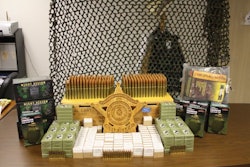Law enforcement's war on gangs has been adversely affected by the tanking economy. This budget crisis has affected large and small departments. Manpower, equipment and money for overtime deployments are all in short supply.
We must all endeavor to get the most bang for our buck. Often in the past, I have recommended that gang units working on the streets should utilize intelligence derived from a good gang cop working in the custody division. Properly employed this small investment in manpower will produce the greatest return.
This valuable intelligence can be further multiplied if the jail gang unit has access to telephone and mail monitoring systems within the jail. Even though the inmates know that their communications will be monitored, they will continue to write and call their homeboys to conduct criminal gang business.
The purpose of this gang jail intelligence unit would be to identify and monitor the activities of street gang members while these disruptive groups are in custody. Gangs are the most influential and disruptive to the security and safety of both inmates and staff of any group in the jails or prisons.
The ability to identify and classify these disruptive gangs and their inmate members and to isolate them from the main inmate population will significantly reduce violence and other in-custody criminal behavior behind the walls. This activity includes petty theft, intimidation, extortion and murder.
These gang members and disruptive groups may be from multiple jurisdictions in and around the jail or prison jurisdiction. The information obtained from these inmates to be of any use must be shared with the affected agencies. This exchange of gang intelligence can be facilitated by organization of a weekly or semi-weekly gang intelligence meeting in which representatives of each jurisdiction attend. During this meeting, gang activity and intelligence would be shared with all in attendance. This will ensure a united and coordinated response to active gang criminal activity would be possible.
The in-custody gang office's first responsibility would be the safety and security of his own facility. The ability of the in-custody officer to identify and classify potentially disruptive inmates would be enhanced by the gang information from the outside made available from the street gang intelligence meeting.
The daily activities of the in-custody gang officer would include:
- Reviewing all custody crime reports.
- Reviewing the facility commander's log of significant activity.
- Briefing from the watch sergeant or watch commander.
- Conducting a survey of line personnel for unusual incidents and activities.
- Contacting in-custody gang informants.
- A log or written recording of both rumors and hard intelligence on gang-related incidents and significant active gang members.
- Monitoring gang inmate mail and telephone communications.
In-custody gang officers are usually more successful in obtaining gang affiliation and enemy information from inmates, because no active gang member wants to be housed in a facility or area controlled by his gang rivals. The custody officers are not usually thought of by the gang members as officers whose job it is to file criminal charges against them.
Unfortunately, the ability of these gang officers to obtain this gang intelligence is being challenged by defense attorneys in court. Courts have long held that the safety and security of the jail and general inmate population was paramount, and supersedes the possible incursion on the rights of an individual inmate. Courts are now turning this idea on its head.
The safety and security of the inmate population and staff are sometimes given secondary consideration to the rights of an individual gang inmate. Some courts are now requiring a Miranda waiver to admit the gang admissions of inmates—even to a classification officer. Of course, the effective custody gang officer will not rely solely on the admissions of the gang members.
A smart gang officer will talk with gang and non-gang inmates. Since the non-gang inmates are often the victims of the gangs and other security threat groups, they commonly will cooperate with staff against the gangs, if their safety can be guaranteed.
Gang intelligence cards, photographs, and gang data taken during custody for computer intelligence files, tend to be more reliable than data generated by a street gang unit. This is often due to the ability of the custody officer to interview the "captive audience" at length without interruption, as opposed to the difficult circumstances often encountered by field gang officers.
If you are a law enforcement administrator, consider multiplying your gang intelligence resources with a gang liaison officer or gang unit in the jail. If you are a gang officer working on the street, consider cultivating an in-custody officer to assist you in the jail. Invite him or her to participate in sweeps and when you serve warrants. This will fire up the sometimes dull routine these officers must often endure, and encourage the exchange of information.
It is common in the custody environment to conduct detailed body and cell searches. This developed skill can be useful when serving search warrants in the field. In my experience, these jail-trained officers often find contraband missed by patrol officers.
There is one final benefit to the use of jail officers to develop gang intelligence. Many of these officers will eventually wind up as patrol officers in the streets. They will have a significant advantage over other new patrol officers because of this experience.
The gang shot callers they got to know in custody are the same ones they will contact in the field. The abilities and skills that they developed in dealing with gang members in the jail will aid them in developing street informants and recognizing criminal gang behavior in the streets. And after a few years as patrol officers, they have the potential to be great gang cops.
















